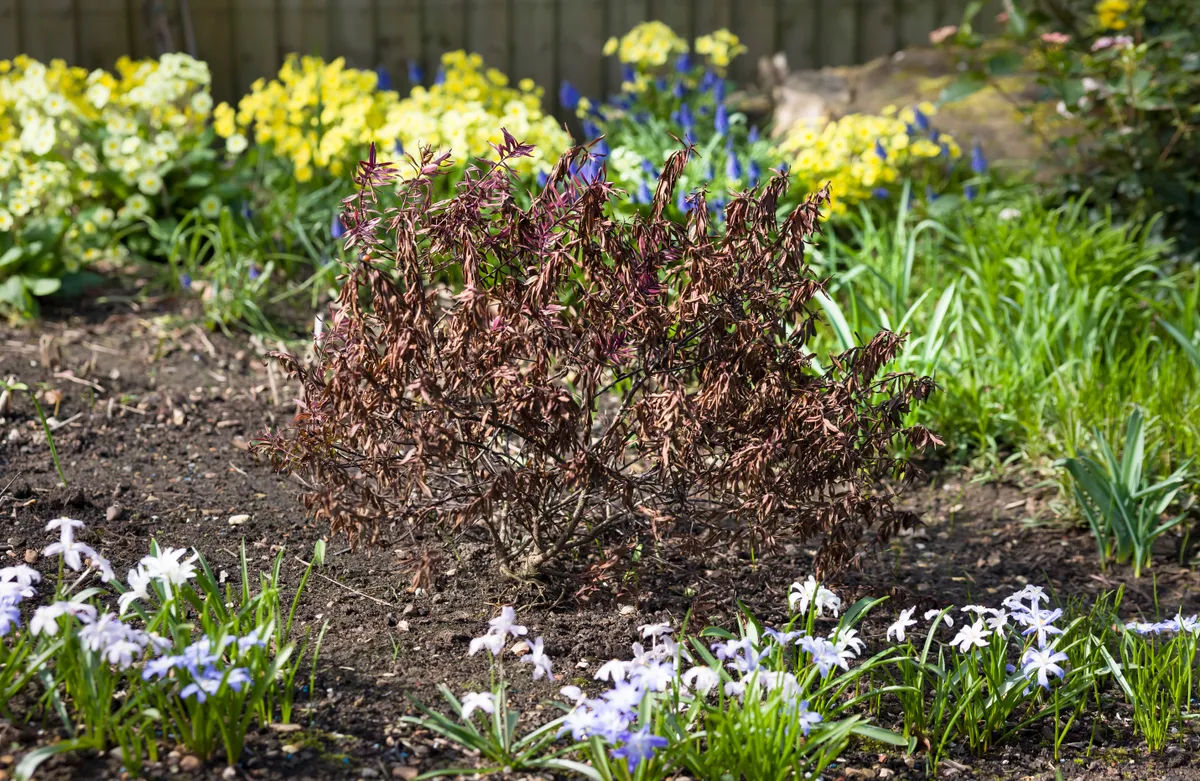From Solway Firth in Scotland to the Peak District and West Wales, and from the edge of Dartmoor in Devon to Oxfordshire, Hertfordshire and Surrey, gardeners have been reporting unusual plant losses in their gardens over the 2022/23 winter to Gardens Illustrated.
Which plants have died?
Evergreen shrubs have been most likely to succumb, with hebes and pittosporums being particularly badly affected. Hebes have been blackened, and pittosporums have lost their leaves.
Almost 71 per cent of respondents to our polls on Instagram and 64 per cent on Twitter told us that they had lost plants this winter. They include rosemary, phormium, cordyline, lavender, euphorbias, ceanothus, star jasmine, topiary bay, cistus, Chinese witch hazel, fatsia, santolina, Erysimum 'Bowles's Mauve', hoheria, physocarpus, parahabe, crinodendron, elaeagnus, abutilon, grevillea, thyme, coronilla, convulvulus, bottle brush (callistemon), euonymus, date palm, daphne, privet, camellia, brassicas, passionflower and winter-flowering clematis.

@katesq24 told us: "It hurts to list them: Hebes, pittosporums, grey leaved cistus (green ones ok), phormiums, parts of rosemary, astelia, Ugni, Euphorbia palustris, ceanothus, Hoheria. Gardening on sand but in an exposed part of Oxfordshire."
Perennial plants have also suffered
Perennials such as penstemon, Oenethera lindheimeri (gaura), Erigeron karvinskianus and salvias, which can often be relied on to make it through the winter in milder areas, also appear to have died. Brassicas such as cauliflowers, Brussels sprouts and purple sprouting broccoli have also succumbed to the cold.
@oxleaze_garden commented on Instagram: "Hebes all dead, sisyrinchium, Euphorbia mellifera and Euphorbia wulfenii, penstemons perished too. Not sure yet about Salvia 'Amistad' and Salvia involucrata yet as they usually survive outside but maybe not this year…"
Many plants affected are borderline hardy
Many of these plants come under the RHS ratings of H3 or H4. H3 plants are classed as 'borderline hardy' – hardy in coastal, mild or sheltered areas except in hard winters and at risk from sudden (early) frosts. H4 plants are considered hardy in an average winter throughout most of the UK, except at altitude or in central or northerly locations. However many gardeners now expect these plants to come through winter unscathed.
Read more about plant hardiness ratings.
Was the 2022/23 winter especially bad?
According to the Met Office, this meteorological winter (December, January and February) was actually slightly milder than average, with an average mean temperature of 4.3°C, 0.2°C above average.
However there was significant rainfall in late autumn, followed by a significant spell of low temperatures in December, which saw temperatures drop as low as -17.3°C in Braemar, Scotland. There were subsequent spells of cold weather, too – including the coldest March temperatures since 2010 that we are currently experiencing.
"In winter, average temperatures can be misleading," explains Guy Barter, chief horticulturalist at the RHS. "It is the extremes in temperature and duration of extremes that are significant. At RHS Garden Wisley we experienced -8C° on two occasions for prolonged periods. A brief dip to -8°C is much less lethal than prolonged periods at -8°C, when the ground freezes. This will put H3 plants at severe risk and imposes much cold stress on H4 plants, which they may or may not survive."
The wet autumn could have contributed – but not the summer drought
Guy does not believe that the drought in summer would have weakened plants: "I would expect hot, dry summers to enhance hardiness, as new growth will be limited and robust and the plants will have an accumulation of carbohydrates from the high light levels promoting photosynthesis - i.e. they will have been hardened. However, this good effect was often undone I suspect by the lush autumn period."
He continues: "Mild, wet conditions in autumn and early winter promotes soft growth. Plants made use of nutrients accumulated during the summer drought as soil organic matter decayed when it was too dry for plants to utilise them. This led to lush soft growth that lacked the hardening normally induced by chilly autumn episodes."
What can gardeners do?
Guy Barter says: "I fear many gardeners, me included, have been a little complacent in applying winter protection, winters having been so mild since 2010. We go to great efforts to shield our Wisley bananas, tree ferns and certain palms - it will be instructive to see if the frost has cut through to damage these plants."
Don't give up hope for your plants just yet, however. "There will clearly be a reckoning this spring and early summer when we survey the damage," says Guy. "I find it can often take until early summer to be sure some plants are dead from frost. In the meantime, prune out dead material – check for green beneath the bark."